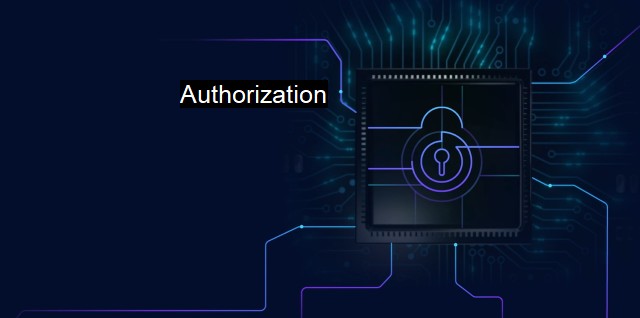What is Authorization?
The Importance of Authorization in Cybersecurity and Antivirus: Securing Sensitive Data and Resources by Controlling Access and Privilege Levels
In the context of cybersecurity and antivirus software, authorization is a fundamental and vital aspect that determines the activities, services, or data every user, device, or program is allowed to access. Often, it is included as one element in a larger security management process, comprising other components like authentication and accounting (also known collectively as AAA), designed to protect systems, data and networks.Authorization establishes rules regarding the actions that users, systems, or applications are allowed to carry out after being validated by the authentication process. Typically, an administrator or system owner bestows those rights and privileges. These assigned privileges manage the operations the user can perform - such as read/write access, the ability to use specific services, access to networks, databases, other applications, or sensitive data. The authorization privileges essentially determine the depth of accessibility or usability that a user or system can have within the whole network, system, or piece of software.
Authorization works to prevent unauthorized and potentially harmful operations or transactions. It makes access control more effective by not allowing unprecedented or unlimited actions on any platform, system, or network, thus limiting the probability of data breaches, leaks, and unauthorized intrusion. It's like putting up a fence within the system or network, with gates unlocked only for those authorised to access those areas.
Antivirus software also uses authorization techniques as part of their risk mitigation and management strategy. An antivirus software aims to protect devices and servers from malicious attacks by viruses, Trojans, worms, or other malware. Authorization in this conventional context can mean several things, such as allowing the software to access specific files and folders, enable security features, or automatically update its virus definition and other crucial software components.
On this note, viruses and other malicious software often try to bypass the authorization with certain tricks like inducing their victims to unknowingly grant them access or taking advantage of security misses in networks, systems, or applications. Against such challenging MALWARES, the importance of having reliable authorization cannot be emphasized enough.
An intelligent antivirus software ensures it is only granting access to what's necessary during its scanning process. This ability to control its own authorization activities also aids in the custody of the user's privacy, where non-essential or sensitive data is secured unless willingly shared by the user.
Within the realm of a network or system, antivirus software often plays an integral part in authorizing activities. an email may not be opened unless scanned and approved by the antivirus software, thereby offering another level of authorization and, thus, protection against potential cybersecurity threats.
Conclusively, authorization, whether through defining user-access rights or allowing certain system-level roles related to antivirus software, is invaluable in ensuring the security of data, applications, and infrastructure. Its application is evidently not their only deterrent for cyber invasion, but its effective and correct implementation can indeed be seen as a hurdle difficult enough to delay, if not wholly discourage, unauthorized access. Therefore in terms of its integration with Authorization is more than just a tool; it is a set of strategies that work in combination with other tools and techniques to ensure secure digital landscapes.

Authorization FAQs
What is authorization in cybersecurity?
Authorization is the process of determining whether a user or entity has the necessary permissions and privileges to access a specific resource or perform a particular action within a system or network. It is a security mechanism that ensures only authorized personnel can access sensitive data and applications.How does authorization differ from authentication in cybersecurity?
Authentication is the process of identifying the user or entity trying to access a system or network, while authorization is the process of determining whether the identified user or entity has the necessary permissions and privileges to access a specific resource or perform a particular action within that system or network. In other words, authentication verifies the identity of a user, while authorization verifies their access rights.What are some common authorization methods used in cybersecurity?
Some common authorization methods used in cybersecurity include role-based access control (RBAC), attribute-based access control (ABAC), and mandatory access control (MAC). RBAC assigns access permissions based on the user's job function, ABAC assigns access based on a set of attributes or characteristics, and MAC enforces access controls based on predefined security policies.Why is authorization important in antivirus software?
Authorization is important in antivirus software because it helps ensure that only authorized users or entities can perform certain actions such as installing or updating the antivirus software, configuring its settings, or performing scans. This helps prevent unauthorized modifications or tampering with the antivirus software, which can compromise its effectiveness and leave the system vulnerable to attacks. Authorization also helps ensure that the antivirus software is operating within the scope of its intended use and cannot be used for malicious purposes.Related Topics
Authentication User permissions Privileged access management Role-based access control Multi-factor authentication
| | A | | | B | | | C | | | D | | | E | | | F | | | G | | | H | | | I | | | J | | | K | | | L | | | M | |
| | N | | | O | | | P | | | Q | | | R | | | S | | | T | | | U | | | V | | | W | | | X | | | Y | | | Z | |
| | 1 | | | 2 | | | 3 | | | 4 | | | 7 | | | 8 | | |||||||